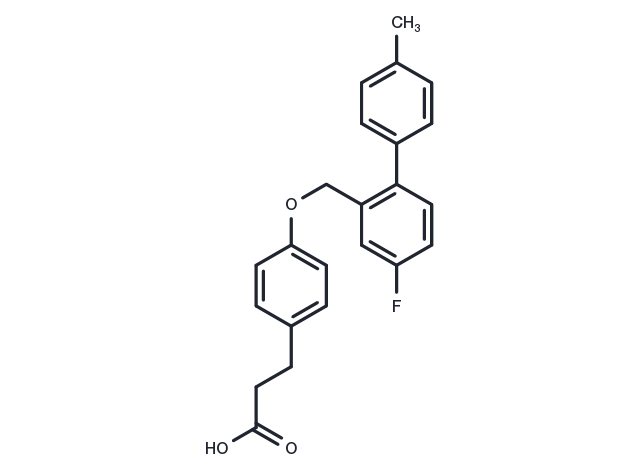Powder: -20°C for 3 years | In solvent: -80°C for 1 year


TUG-891 is a G protein-coupled receptor (GPCR) expressed in intestine, adipocytes, and pro-inflammatory macrophages that is activated by long chain free fatty acids.

| Pack Size | Availability | Price/USD | Quantity |
|---|---|---|---|
| 1 mg | In stock | $ 34.00 | |
| 2 mg | In stock | $ 47.00 | |
| 5 mg | In stock | $ 77.00 | |
| 10 mg | In stock | $ 117.00 | |
| 25 mg | In stock | $ 237.00 | |
| 50 mg | In stock | $ 397.00 | |
| 100 mg | In stock | $ 582.00 | |
| 500 mg | In stock | $ 1,230.00 | |
| 1 mL * 10 mM (in DMSO) | In stock | $ 85.00 |



| Description | TUG-891 is a G protein-coupled receptor (GPCR) expressed in intestine, adipocytes, and pro-inflammatory macrophages that is activated by long chain free fatty acids. |
| In vitro | TUG-891 exhibits analogous signaling characteristics to the long-chain fatty acid (LCFA) α-linolenic acid at the human Free Fatty Acid receptor 4 (FFA4), stimulating Ca2+ mobilization, recruiting β-arrestin-1 and β-arrestin-2, and promoting extracellular signal-regulated kinase phosphorylation. Moreover, TUG-891 activation of FFA4 leads to the receptor's swift phosphorylation and internalization[1]. |
| Kinase Assay | Inhibition of recombinant human Mps1 by BAY 1161909 or BAY 1217389 is assessed in TRFRET-based in vitro kinase assays via phosphorylation of a biotinylated peptide (Biotin-Ahx-PWDPDDADITEILG-NH2). Under standard assay conditions kinase and test compound are preincubated for 15 min before enzyme reaction is started by addition of substrate and ATP upon 10 μM[1]. |
| Synonyms | TUG 891, TUG891 |
| Molecular Weight | 364.41 |
| Formula | C23H21FO3 |
| CAS No. | 1374516-07-0 |
Powder: -20°C for 3 years | In solvent: -80°C for 1 year
DMSO: 36.4 mg/mL(100 mM)
H2O: < 1 mg/mL (insoluble or slightly soluble)
You can also refer to dose conversion for different animals. More
bottom
Please see Inhibitor Handling Instructions for more frequently ask questions. Topics include: how to prepare stock solutions, how to store products, and cautions on cell-based assays & animal experiments, etc.
TUG-891 1374516-07-0 Endocrinology/Hormones GPCR/G Protein GPR Inhibitor inhibit Free Fatty Acid Receptor TUG 891 TUG891 FFAR inhibitor
